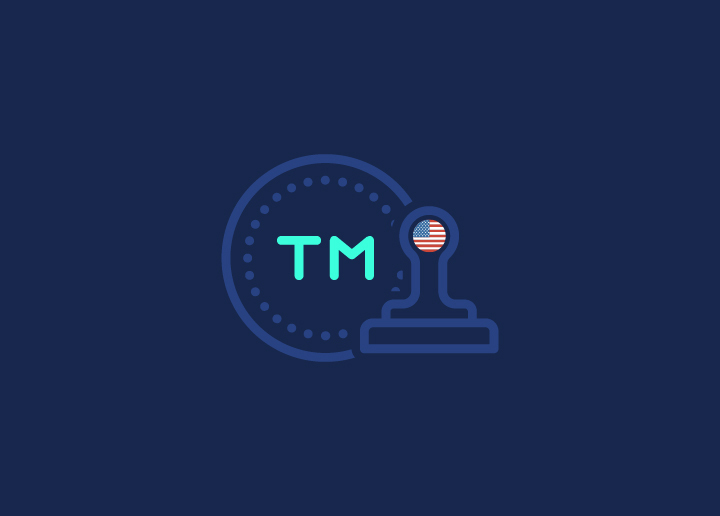Want to protect your brand and intellectual property on the web? Learn “how to register a trademark in the USA” with our step-by-step guide. We’ll cover everything from understanding a trademark to filing your registration.
Key Takeaways
- Federally registering a trademark provides nationwide protection, legal presumption of ownership, and the ability to bring a lawsuit in federal court.
- Conducting a comprehensive trademark search using TESS (The Trademark Electronic Search System), available through the USPTO (United States Patent and Trademark Office), is essential to avoid potential conflicts and ensure your trademark is unique and protectable.
- Maintaining a trademark requires continuous use in commerce and timely filings, including a Declaration of Use and/or Excusable Nonuse between the fifth and sixth years after registration and every ten years thereafter.
Contents
ToggleUnderstanding Trademarks
A trademark, which could be a word, phrase, symbol, design, or combination thereof, serves to identify your goods or services and set them apart from others. Trademarks are pivotal in the marketplace as they help consumers identify and trust your brand amidst a sea of competitors.

- While trademarks are used for goods, service marks (brand name or logo) are used to identify and distinguish services. Both play an essential role in protecting your brand from counterfeiting and fraud.
- Owning a trademark grants your brand legal protection, preventing others from using similar marks that might mislead consumers.
- By using trademark symbols such as TM for trademarks and SM for service marks, you signal to others that you are claiming ownership of these marks.
- Once registered, the ® symbol can be used, which offers further legal protection and recognition.
- Creative and unique trademarks are particularly valuable, as they are easier to protect and more effective in differentiating your brand.
Trademarks extend beyond mere names and logos – they can encompass sounds, colors, and, in certain situations, even smells. These variations allow for a wide range of branding opportunities, ensuring your business stands out uniquely.
Read: Logo Design Trends to Boost Your Brand
How Can TramaTM Help Register Your Trademark in the USA?
If you want to start with registering your trademark in the USA, seeking professional help from TramaTM, one of the leading trademark registration service providers in the country, is a wise choice.

Not only does TramaTM simplify the process of securing your trademark in the USA, but it also offers global coverage. With a focus on transparency, efficiency, and legal expertise, TramaTM provides a range of benefits to ensure a smooth and successful trademark registration experience.
Benefits of Using TramaTM
Here are some of the benefits of registering your trademark in the USA with TramaTM:
- Free Lawyer’s Check: The process with TramaTM starts with a free check for similar trademarks that could impede your application. Receive results within 24 hours, allowing you to proceed confidently in the registration process.
- High Success Rate: Benefit from a 96%+ application success rate.
- Transparent Pricing: Clear and upfront pricing with no hidden fees.
- Simple Process: Register your trademark in three easy steps.
- Global Coverage: Register your trademark worldwide with TramaTM’s extensive network.
- Trademark Monitoring: Continuous monitoring to protect your trademark.
How TramaTM Works
The trademark registration process with TramaTM is straightforward:
Step 1: Free Lawyer’s Check
The easiest way to start the registration process is by submitting your mark for a free lawyer’s check, which can be done HERE. TramaTM’s lawyers will check whether your trademark is registrable, identify any potential risks, and determine the appropriate classes for trademark registration.
Step 2: Fill out the Order Form and Payment
The process continues by filling out the order form with basic information, such as billing details. Once the order is placed, payment can be made via credit/debit card or bank transfer. After selecting the payment method and placing the order, you will receive a confirmation email.
Step 3: Application Review and Approval
TramaTM’s lawyers will prepare the draft of your application (in about 4 business days) with a downloadable Power of Attorney and send it to you for your review and approval.
Step 4: Application Filing
Upon approval and receipt of all necessary information, TramaTM will file the application on your behalf and send a confirmation email. You are then protected from the date of filing and can start using the symbol TM.
Secure Your Trademark with TramaTM
Don’t risk losing what you’ve worked hard to build. Discuss your specific needs and get expert advice on how to best protect your brand identity.
Difference Between Trademark and Copyright
Here is a brief table highlighting the key differences between trademarks and copyrights, specifically in terms of creative works on a website:
| Aspect | Trademark | Copyright |
| Purpose | Protects brand identifiers (names, logos) | Protects original creative works (text, images, illustrations, artwork) |
| Scope of Protection | Business names, logos, slogans, symbols | Written words, text, images, illustrations, artwork |
| Registration Authority | USPTO (United States Patent and Trademark Office) | U.S. Copyright Office |
| Duration | Indefinite, with renewal every 10 years | Lifetime of the author plus 70 years |
| Usage Requirement | Must be used in commerce | Automatically granted upon creation |
| Symbol | ™ (unregistered), ® (registered) | © |
| Rights Granted | Exclusive right to use the mark in commerce | Exclusive rights to reproduce, distribute, perform, and display the work |
How to Register a Trademark in the USA: 7 Steps
If you want to register your trademark on your own, follow this 7-step guide. Before starting the trademark filing process, it’s essential to determine whether a trademark is necessary for your business. Common law trademark rights are established simply by using the trademark in your business operations within a specific geographic area. While this offers some protection, these rights are geographically limited and can be challenging to enforce.
Step 1. Deciding If You Need a Trademark
Understanding trademark law can help you make an informed decision about whether to pursue a formal trademark filing.

Federally registering your trademark provides the following benefits:
- Broader rights and protections compared to common law trademarks
- Nationwide protection
- Legal presumption of ownership, which can deter others from using similar marks
- Listing in the USPTO database makes it easier to enforce your rights and prevent potential infringements.
The TM symbol can signify common or state law trademark rights or indicate a pending federal trademark registration. However, the benefits of a registered trademark, including the ability to bring a lawsuit in federal court and the potential to recover damages, make the process of registration through the USPTO a worthwhile consideration for most businesses.
Know more: Best Branding Ideas for Your Business
Step 2. Conducting a Comprehensive Search
Conducting an exhaustive search before using a trademark or applying for federal registration is of utmost importance. The TESS (Trademark Electronic Search System) is a valuable tool for this purpose.
- The ‘Design Search Code‘ manual in TESS provides the most flexibility for searching. It allows you to narrow results using field codes, such as [BI] for words in a mark or [ON] for the owner’s name.
- A thorough search should include variations of the mark, such as different spellings or plural forms, to cover all bases.
- Truncation characters like ‘$’ or ‘*’ can help find these variations during the search.
- Boolean operators like ‘AND’, ‘OR’, and ‘NOT’ can be utilized within TESS to combine search terms effectively, ensuring a comprehensive search.
- Beyond exact matches, it is essential to search for partial matches and pseudo marks, which include translations and correct spellings of deliberate misspellings.
This thorough approach helps prevent potential conflicts and ensures your trademark is unique and protectable. Overlooking this step can lead to costly legal disputes or rebranding efforts down the line.
Related: How to Rebrand Your WordPress Website
Step 3. Preparing Your Trademark Application
After confirming your trademark’s uniqueness, the subsequent step involves preparing your trademark application. Here are the key details you need to include:

- Personal details: Your name, address, and email.
- Description of goods or services: Provide a detailed description of the goods or services associated with the mark.
- Filing basis: Select a filing basis, such as use in commerce or intent to use.
It is essential to provide a clear representation of the mark, whether it is a word, design, or combination. Foreign-domiciled applicants using TEAS Plus must have a U.S.-licensed trademark attorney complete and submit the initial application. Meanwhile, an attorney is required after submission in the TEAS Standard.
Choosing between TEAS Plus and TEAS Standard depends on your needs.
- TEAS Plus has more upfront requirements but lower fees.
- TEAS Standard offers more flexibility but at a higher cost.
These details ensure your application is complete and ready for submission, setting the stage for a smooth filing process.
Read about: WordPress Quicksite Services to Take Your Brand Online
Step 4. Filing Your Trademark Application
When filing your trademark application, you must choose between TEAS Plus and TEAS Standard.
- TEAS Plus requires more upfront information but costs less per class of goods/services, at $250. This option necessitates choosing from the Trademark Identification Manual and paying all fees upfront, including the filing fee.
- TEAS Standard, on the other hand, costs $350 per class but allows for fewer upfront requirements and the option to pay fees incrementally.
The choice between TEAS Plus and TEAS Standard depends on your specific needs and readiness to provide detailed information at the outset. Both options have their merits, and understanding the differences helps you make an informed decision.
After selecting your filing option, the application process involves:
- Submitting your application through the Trademark Electronic Application System (TEAS).
- Ensure all information is accurate to avoid delays or rejections.
This step is critical in securing your trademark and moving forward in the registration process.
Learn about: Using Archetypes to Define Your Brand
Step 5. USPTO Examination Process
Post-application filing, the US Patent and Trademark Office commences its examination process. An examining attorney reviews your application and may issue an office action if there are legal problems with the trademark or its application.
- Office actions are official letters outlining issues that need to be addressed, with a response deadline of three months, extendable to six months if requested.
- Responding to office actions requires addressing each issue raised comprehensively.
- If the delay in responding is unintentional, a Petition to Revive can be submitted.
- If a final refusal is issued, you can file a Request for Reconsideration before the appeal deadline, along with a Notice of Appeal if you wish to challenge the refusal.
This examination process, which is a critical juncture in the entire trademark application process, requires attention to detail and timely responses to ensure your application progresses smoothly.
Step 6. Publication in the Trademark Official Gazette
Your application is published in the Trademark Official Gazette every Tuesday upon approval by the USPTO examining attorney.
- A Notice of Publication is sent to the applicant, usually about two months after approval. This publication initiates a 30-day opposition period during which members of the public can file a Notice of Opposition.
- If no opposition is filed within the 30-day period, the application moves to the next stage of the registration process. However, if an opposition is filed, the Trademark Trial and Appeal Board (TTAB) will hear the case and issue a decision within six months.
Publication in the Trademark Official Gazette is a significant milestone. It brings your trademark one step closer to registration, provided no opposition arises during the publication period.
Step 7. Registration Certificate Issuance
Should no opposition be filed, the USPTO, also known as the trademark office, proceeds to issue an electronic registration certificate. The electronic certificate includes the Director’s signature and a digital gold seal for authentication.
Trademark owners receive an email with a link to access their certificate via the Trademark Status and Document Retrieval (TSDR) system.
Owners can:
- View, download, and print their registration certificates at any time without charge.
- Order printed presentation copies for display purposes.
- Order certified copies for $15, which can be used in legal proceedings or international filings.
Receiving your registration certificate is a momentous achievement, marking your trademark’s official recognition and protection. To reach this milestone, it’s essential to register your trademark, ensuring its uniqueness and safeguarding your brand.
Maintaining Your Trademark
To maintain your trademark registration, you must use it continuously in commerce and make filings in a timely manner. The owner must also submit specific maintenance documents regularly to keep the registration active and up to date. These include a Declaration of Use and/or Excusable Nonuse between the fifth and sixth years after registration.

- A Declaration of Use and/or Excusable Nonuse and an Application for Renewal are required every ten years.
- Failure to file these documents before the deadlines will result in the registration’s cancellation or expiration.
- A six-month grace period is available, but late filings incur additional fees.
Maintaining your trademark ensures continued protection and prevents the loss of your valuable brand identity.
International Trademark Protection
For international trademark protection, you can either file individual trademark applications in each country of interest or use the Madrid System.
- The Madrid System allows for a single international application based on a pending US trademark application covering 193 member states. This system simplifies managing international trademarks with one representative.
- Renewing a foreign registration under the Madrid Protocol must be done directly with the International Bureau of WIPO.
- For Madrid Protocol-based registrations between the fifth and sixth years, a Declaration of Use and/or Excusable Nonuse is required.
As businesses expand globally, securing trademark protection in international markets is crucial for safeguarding your brand identity and preventing infringement. Forming a limited liability company can be an effective way to achieve this goal.
Also read: Transform Your Brand with These Top White Label Agencies
Summary
In summary, navigating the trademark registration process in the USA involves multiple steps, from understanding trademarks and deciding on registration to conducting searches, filing applications, and maintaining your trademark.
By following this guide, you can ensure your brand is well-protected, both domestically and internationally, paving the way for long-term success. And, If you require any help, you can contact TramaTM to register your trademark easily.
FAQs About Registering a Trademark in the USA
What is the difference between a trademark and a service mark?
The main difference between a trademark and a service mark is that a trademark identifies goods, while a service mark identifies services. Both offer legal protection for your brand.
Do I need a trademark attorney to file my application?
Having a trademark attorney is not mandatory, but it can be beneficial in navigating the complex application process, especially for foreign applicants. They can provide valuable expertise and guidance throughout the process.
How long does the trademark registration process take?
The trademark registration process can take several months to over a year, depending on the completeness of the application and any issues that arise during the examination. It varies case by case and can be lengthy.
What happens if I receive an office action?
If you receive an office action, you need to carefully review the issues mentioned and respond within the given timeframe to resolve them. Failure to do so can result in your application being rejected.
Can I protect my trademark internationally?
Yes, you can protect your trademark internationally by filing through individual countries or using the Madrid System for a single international application.
















